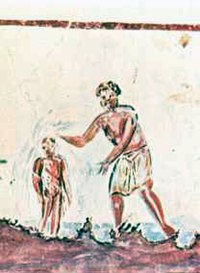
CHEAP TRAVEL EUROPE
CATACOMB SAN CALLISTO
Catacombs of San Callisto
Sited along the Appian way, these catacombs were built after AD 150, with some private Christian hypogea and a funeral area directly dependent on the Catholic Church. It takes its name from the deacon Saint Callixtus, proposed by Pope Zephyrinus in the administration of the same cemetery - on his accession as pope, he enlarged the complex, that quite soon became the official one for the Roman Church. The arcades, where more than fifty martyrs and sixteen pontiffs are buried, form part of a complex graveyard that occupies fifteen hectares and is almost twenty km long.
This catacomb's most ancient parts are the crypt of Lucina, the region of the Popes and the region of Saint Cecilia, where some of the most sacred memories of the place are preserved (including the crypt of the Popes, the crypt of Saint Cecilia, and the crypt of the Sacraments); the other regions are named the region of Saint Gaius and the region of Saint Eusebius (end of the 3rd century), West region (built in the first half of the 4th century) and the Liberian region (second half of the 4th century), all showing grandiose underground architecture. A modern staircase, on the site of an ancient one, was built by Pope Damasus I, giving access to the region of the Popes, in which is to be found the crypt of the popes, where nine pontiffs and, perhaps, eight representatives of the ecclesiastical hierarchy had been buried - along its walls are the original Greek inscriptions for the pontiffs Pontian, Anterus, Fabian, Lucius I and Eutychian. In the far wall Pope Sixtus II was also buried, after he was killed during the persecution of Valerian; in front of his tomb Pope Damasus had carved an inscription in poetic metre in characters thought up by the calligrapher Furius Dionisius Filocalus.
In the adjoining crypt is the grave of Saint Cecilia, whose relics were removed by Pope Paschal I in 821: the early 9th century frescoes on the walls represent Saint Cecilia praying, the bust of the Redeemer and Pope Urban I. A short distance away, an arcade dating to the end of the 2nd century gives access to the cubicula of the sacraments, with their frescoes from the first half of the 3rd century hinting at baptism, the Eucharist and the resurrection of the flesh; in the region of Saint Militiades next door, a child's sarcophagus has a front sculpted with biblical episodes. In the region of Saints Gaius and Eusebius are some crypts set apart, opposite each other, with the tombs of Pope Gaius (with an inscription) and Pope Eusebius, who died in Sicily where he had been exiled by Maxentius and whose body was translated to Rome during the pontificate of Militiades; on a marble copy of the end of the 4th century (of which fragments may be seen on the opposite wall) may be read of an inscription by Damasus on the schism provoked by Heraclius over the matter of the lapsi.

Joining onto the arcade itself are, in succession, the crypt of the martyrs Calogerus and Parthenius and the double cubiculum of Severus, which contains a rhythmic inscription (dated to no later than 304) in which a bishop of Rome (at that time Marcellinus is first called pope and first openly professes belief in the final resurrection. In a region further from there is the burial of Pope Cornelius, whose tomb still has its original inscription giving him the title of martyr and, on its sides, splendid paintings with figures in 7th and 8th century Byzantine style representing popes Sixtus II and Cornelius and the African bishops Cyprian and Ottatus. In a nearby cubiculum are some of the most ancient burials, after AD 175, with Roman frescoes of (on the ceiling) the Good Shepherd and orantes and (on the far wall) two fish with a basket of loaves behind it, a symbol of the Eucharist.
